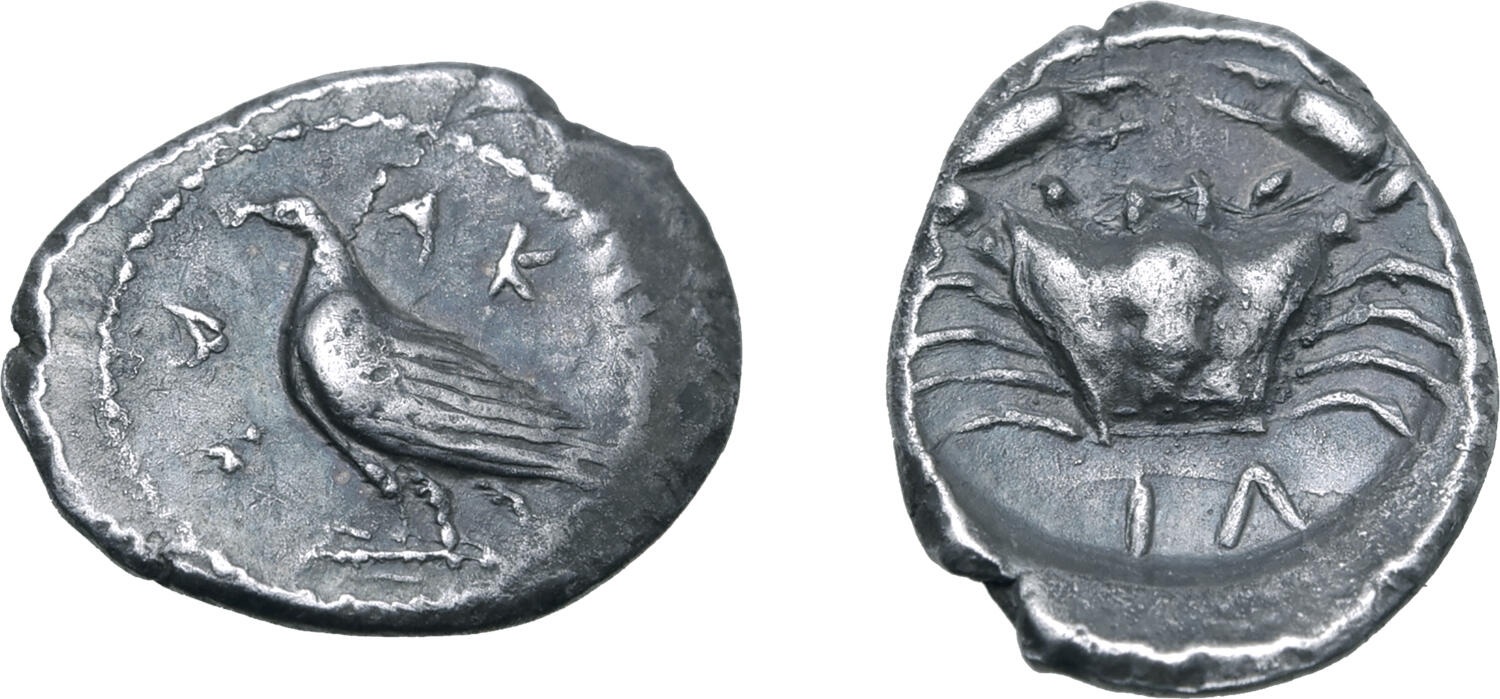S 1497 - Agrigentum, silver, litrai (450-440 BCE)
From SILVER
450 BCE - 440 BCE Silver 905 kg
Description
| ObverseInscription or printing placed on the obverse.: | AK-RA across fields (Greek).Sea eagle standing to left on Ionic capital |
| ReverseInscription or printing placed on the reverse.: | IΛ (retrograde, mark of value) below (Greek).Crab |
Mint and issuing power
| MintIdentifies the place of manufacture or issue of a numismatic object.: | Agrigentum | Ancient regionAncient region.: | Sicily | Modern countryModern country: Italy | AuthorityIdentifies the issuing power. The authority can be "pretended" when the name or the portrait of X is on the coin but he/she was not the issuing power. It can also be "uncertain" when there is no mention of X on the coin but he/she was the issuing power according to the historical sources: |
Chronology
| FromIdentifies the initial date in a range assigned in a numismatic context. | 450 BCE | toIdentifies the final date in a range assigned in a numismatic context.. | 440 BCE | PeriodTime period of the numismatic object.: Classical 480-323 BC |
Physical description
| MetalThe physical material (usually metal) from which an object is made.: | Silver |
Median weightMedian of the weights of numismatic objects (in grams). in grams | 0.85 | DenominationTerm indicating the value of a numismatic object. Examples: tetradrachm, chalkous, denarius.: | litra |
StandardStandard.: |
Image

S 1497 - Agrigentum, silver, litrai (450-440 BCE).jpg [1]
References
| Die study referencePublication of the study: | Westermark 20181Westermark 2018, p. 143-155, n° 448-514 | ||
| Coin series referenceReference to coin series study: | Sear I2Sear I, n° 746, HGC 23HGC 2, n° 121 | ||
| Coin series web referenceCoin series web references: | |||
Obverse dies distribution
| FrequencyFrequency of specimen in distribution. ᵖ | Number of obversesNumber of obverse dies. ᵖ (o) | % (o) | Number of coinsNumber of coins. (n) | % (n) | Die nameName(s) of the die(s). |
| 1 | 13 | 27.08 | 13 | 5.37 | 5;6;18;21;28;32;33;36;37;38;39;40;44 |
| 2 | 8 | 16.67 | 16 | 6.61 | 3;7;14;15;22;27;45;47 |
| 3 | 6 | 12.5 | 18 | 7.44 | 19;23;30;41;42;48 |
| 4 | 7 | 14.58 | 28 | 11.57 | 4;9;16;17;29;34;46 |
| 6 | 3 | 6.25 | 18 | 7.44 | 8;26;31 |
| 7 | 2 | 4.17 | 14 | 5.79 | 13;43 |
| 8 | 1 | 2.08 | 8 | 3.31 | 10 |
| 9 | 3 | 6.25 | 27 | 11.16 | 24;25;35 |
| 10 | 1 | 2.08 | 10 | 4.13 | 20 |
| 11 | 1 | 2.08 | 11 | 4.55 | 12 |
| 12 | 1 | 2.08 | 12 | 4.96 | 11 |
| 15 | 1 | 2.08 | 15 | 6.2 | 1 |
| 52 | 1 | 2.08 | 52 | 21.49 | 1 |
| Total | 48 of 48 | 99.98 | 242 of 242 | 100.02 |
Reverse dies distribution
no distribution is available
Quantification
| Number of obversesNumber of obverse dies. ᵖ (o) | 48 | Number of singletons (o1)The number of singleton coins. ᵖ | 13 |
| Number of reverse diesNumber of reverse dies. (r) | 42 | Number of coinsNumber of coins. (n) | 242 |
| Coins per obverse dieNumber of coins per obverse die. (n/o) | 5.04 | Coins per reverse dieNumber of coins per reverse die. (n/r) | 5.76 |
| Reverse per obverse ratioRatio of obverse dies divided by reverse dies. (r/o) | 0.88 | Percentage of singletons (o1)number of coins (n) divided by the number of singletons (o1) ᵖ | 27.08 % |
| Original number of dies (O) (Carter 1983 formula)The estimation of the number of coins according to Carter 1983 ᵖ | 53.23 | Coins struck if 20,000 as average productivity per dieCoins made if the average productivity for obverses (according to Carter) is 20,000. ᵖ | 1,064,600 |
| Original number of dies (O) (Esty 2011 formula)The estimation of the number of coins according to the singleton formula in Esty 2011 ᵖ (O) | 59.88 | Survival rate if 20,000 as average productivity per dieSurvival rate if average productivity is 20,000. ᵖ | 0.00023 |
| Coverage (o = % of O) (Esty 1984 formula)Esty 1984 - coverage (% of O) ᵖ (o = % of O) | 94.63% | Die productivity if survival rate 1/2,000Average productivity if survival rate is 1/2,000. ᵖ | 9,092.62 |
| Weight of silver (in kg) if 20,000 coins per die (O = Carter formula)Carter 1983 * Median weight * 20000 (*10 if gold or electrum) ᵖ | 905 kg <br /> 905 kg | Die productivity if survival rate 1/5,000Average productivity if survival rate is 1/5,000. ᵖ | 22,731.54 |
Remarks
Most likely two workstations